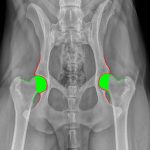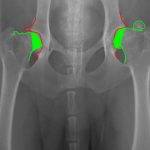Dog hip dysplasia (CHD – Canine Hip Dysplasia) is a malformation of the hip joint – instead of a nice round ball fitting smoothly into a deep socket, the joint contains a shallow socket and irregularly shaped ball. These malformations cause uneven contact between the joint surfaces, as well as compromised stability. Arthritis is an expected outcome from having dog hip dysplasia.
Typically the root cause of CHD is genetic, however rapid weight gain or growth, and either over or under exercising can also contribute to its manifestation. Per the Orthopedic Foundation of Animals, Bulldogs are the number 1 dog suffering from CHS.

 Here are x-rays of “normal” dog hips. For the sake of full disclosure, these are NOT bulldogge hips as you will very seldom ever see bulldogge hips this clean. The red line highlights the socket and the green line outlines the femoral head (ball) and neck. Notice the hourglass appearance of the thin femoral neck. The region of solid green color represents the part of the femoral head that is buried within the socket. Also note in the first x-ray the absences of any jagged edges or arthritis around the femoral head. In a perfect world, this is what you should strive to obtain.
Here are x-rays of “normal” dog hips. For the sake of full disclosure, these are NOT bulldogge hips as you will very seldom ever see bulldogge hips this clean. The red line highlights the socket and the green line outlines the femoral head (ball) and neck. Notice the hourglass appearance of the thin femoral neck. The region of solid green color represents the part of the femoral head that is buried within the socket. Also note in the first x-ray the absences of any jagged edges or arthritis around the femoral head. In a perfect world, this is what you should strive to obtain.
 This is an x-ray of a dog that has severe CHD. Notice the areas of roughened bone, with spurs off the top of the socket and extra calcified masses. These regions of extra bone growth indicate degenerative arthritic change. Both the ball and the socket are irregularly shaped and fit together poorly. There is poor coverage of the femoral head.
This is an x-ray of a dog that has severe CHD. Notice the areas of roughened bone, with spurs off the top of the socket and extra calcified masses. These regions of extra bone growth indicate degenerative arthritic change. Both the ball and the socket are irregularly shaped and fit together poorly. There is poor coverage of the femoral head.
 The femoral head and neck are outlined in green. Notice how thickened femoral neck is compared to the normal dog hip x-rays. The region of solid green color reflects the amount of femoral head that is seated within the socket. Notice how much flatter femoral heads are and how little of they are seating into the sockets as compared to that of the normal dog hip x-ray. The green or red circles with no coloring in the center represent abnormal calcified masses.
The femoral head and neck are outlined in green. Notice how thickened femoral neck is compared to the normal dog hip x-rays. The region of solid green color reflects the amount of femoral head that is seated within the socket. Notice how much flatter femoral heads are and how little of they are seating into the sockets as compared to that of the normal dog hip x-ray. The green or red circles with no coloring in the center represent abnormal calcified masses.
Believe it or not, despite these horrific looking x-rays, with minimal treatment this dog can lead a fairly active with only the occasional use of prescription medication. Approximately 75 percent of young dogs with CHD can maintain function well into their senior years without developing hip pain. Although medical and surgical options are available for young and mature pets with CHD, most dogs are initially treated with medical supervision.
Keys:
- First and foremost, consult with your DVM.
- Keep the rest of the dogs body as fit and strong as possible. The dogs weight and overall health condition is typically the underlying catalyst.
- Treat the inflamed joint itself using nutriceuticals (glucosamine, omega-3’s etc.), a structured exercise program to build hip strength and stability, manual therapy, if needed. Other nonsurgical treatment may include acupuncture and anti-inflammatories.